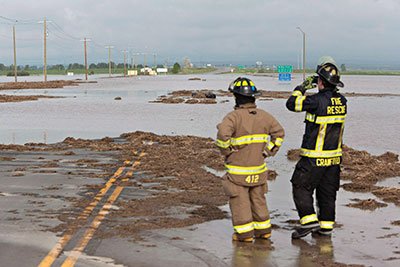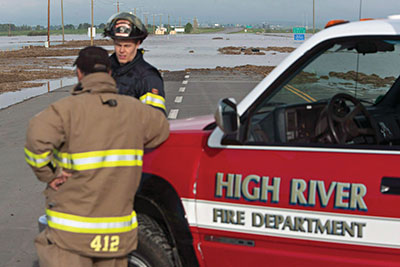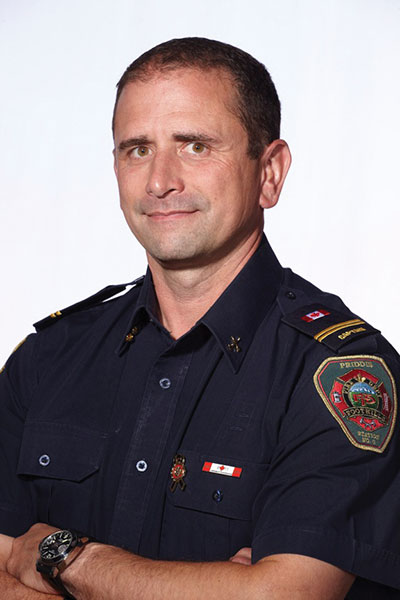
Features
Hot topics
Incident reports
Back-line heroes – Alberta Floods
On June 20, at exactly 0813, I was sitting on the couch preparing to enjoy a well-deserved day off when the phone rang.
July 29, 2013
By Chad Sartison
On June 20, at exactly 0813, I was sitting on the couch preparing to enjoy a well-deserved day off when the phone rang. I was on another call at the time but noticed it was Chief Jim Smith. Typically, the chief doesn’t call unless he has something to say, so I asked the other line to hold and I answered.
 |
|
| Firefighters survey a washed-out road in High River, Alta. In June, floodwaters tore through the town, flowing at an unprecedented 2,000 cubic metres per second. Photos by The Canadian Press
|
“Hello Chief,” I said in an inquisitive tone. Skipping any pleasantries, the chief asked if I could report to the High River Emergency Operations Centre (EOC) immediately and contribute where I could. Leaning over, I peered out the window at what was a beautiful sunny day. A little dramatic I thought, but hey, what the chief wants the chief gets, so off to the closet I went to get into uniform.
What could warrant such a call, I wondered, as I grabbed my radio and got into my car. I texted my senior man, Craig Stewart, to see if he had gotten the tap on the shoulder but there was no answer. Struggling with the guilty thoughts of wanting action but knowing the ramifications to others, I admit to being torn between being excited to use the ICS training I had acquired over the years, and deploying to the front lines where the movies tell us heroes are born.
The town of High River (insert irony here) was expecting higher-than-average water flows and had begun preparations for what was expected to be a repeat of the 2005 flood, during which the water ran at more than 800 cubic metres per second. Little did any of us know at the time that we were driving into what would soon be an unprecedented wall of water measuring more than 2,000 cubic metres per second.
About 45 minutes had passed since the chief’s call. Not much to see here, I thought to myself as I pulled into town. Fighting the urge to stop by Tim Hortons, I soldiered toward the town offices, where the EOC was set up. I was about 10 blocks into town when I noticed some water on the streets. Cool, I thought. Never been to an official flood before. It was another five blocks when I realized that perhaps all was not as it seemed.
The roads began to quickly fill with fast-moving water and pandemonium began to take hold of the town. Horns were honking and cars were moving in every direction out of town, resembling rats trying to abandon a scuttled ship. I’d better hurry up and get to the EOC, I said to myself, as I simultaneously began to regret my choice of automobiles.
I had elected to take my sports car, leaving behind my perfectly suited pickup truck. Stupid, I thought; the car was low to the ground and built to gobble up air into its V10 engine. I was now driving in 10 inches of fast-moving water and air was quickly becoming a precious commodity.
Recalling my 1021 command training at which we discussed ongoing scene assessment and tactical change, I came to the conclusion that it is an officer’s prerogative to change his mind as long as he does so quickly! I pulled a dramatic U-turn and joined the High River residents as they were abandoning ship. Immediately hitting gridlock, my patience quickly grew thin as I could hear my muffler choke from the pressure of the quickly rising water.
Looking ahead, I pulled into oncoming traffic and raced down the opposite side of the road. Almost immediately, law-abiding citizens began to object with their horns and shake their fists while others swerved to cut me off. What they did not know is that I had spotted some traffic officers desperately trying to control the chaos at the approaching lights. I squealed to a stop, jumped out of my car and informed the officers of the wall of water coming their way. I suggested that they stop all incoming traffic and double-lane the citizens out of town.
Taking advantage of the ground I had gained, I helped the officers push a stalled car with its occupant still in the driver’s seat out of the way, and I raced to the fire hall. I immediately tried to hitch a ride to the EOC. The driver of the first apparatus I asked said, “Don’t bother, brother; the EOC is under six feet of water. It’s coming to you.”
The 911 dispatch was chaotic with emergency calls coming in every 20 seconds. I remember listening with admiration and envy to how the dispatchers kept it together. “High River Fire, respond to a 40-year-old female clinging to a tree,” with High River Chief Len Zebedee replying, “Tell her to hang on, we’ll be right there!!!”
I remember thinking that there was nowhere else on the planet I wanted to be when suddenly, Chief Smith (my chief) said, “Pack your bags, we are pulling back to Foothills EOC.” Alone in my car, I caught myself cussing the whole way back; if you are a firefighter you don’t have to ask why!

|
|
| Firefighters in High River, Alta., stand near a road washed out by floodwaters. During the first day of flooding, dispatch was inundated with emergency calls every 20 seconds. |
Back at the Foothills EOC, all was calm – almost devoid of any indication of the tragedy unfolding 30 kilometres away. Then came the order, the secondary EOC at the High River fire hall was in danger of flooding and everyone was evacuating to our EOC in Heritage Pointe. It was over the next couple of days that I began to realize that heroes are not born only on the front lines as Hollywood leads us to believe.
It was Day 2 when my team was deployed to relieve command at the Blackie Evacuation Centre. Are you kidding? Oversee a bunch of evacuees? My only hope is that I was able to hide the disappointment in my eyes better than some of the younger members of my team.
Immediately upon arriving at the evacuation centre, it became glaringly apparent that there was a tremendous amount of work to be done. With no time to mope, my team members dug into their jobs and never looked up for 14 hours. It wasn’t glamorous work. We never pulled anyone that day from the precipice of an angry river. We never managed a hot loading zone, unloading helicopter evacuees snatched from rooftops, or saved any puppy dogs desperately looking for higher ground.
We did, however, give more than 250 citizens warm clothes and a compassionate ear as the reality of the day began to reveal itself in the eyes of our customers who had lost everything.
What I am trying to say is that when we received that assignment, none of us particularly wanted it, including me. Yet as captain, I don’t have the luxury to choose assignments, and had no choice but to put my – and, in turn, my team’s – best foot forward. I will always think it unfortunate that some of our younger firefighters will never be able to see beyond the action that they missed that day and appreciate the incalculable contribution they made.
All too often in fire we focus on the tactical side of our jobs. However, for every trench there is a backroom hero tasking, developing, formulating and strategizing, thinking ahead of the emergency and making sure we are able to serve our communities and come home safely to our families.
It takes unimaginable courage to send a firefighter into harm’s way, and even more to ask him to leave someone behind. The back rooms are often where our battles are won and lost, and in High River that day Chief Zebedee, his command staff and their High River firefighters combined with firefighters from all over the region to win an unwinnable battle. Sadly we lost three beautiful citizens that day but saved countless others and, amazingly, never lost an emergency responder.
It was in these EOCs that I was privileged to witness unparalleled heroics from countless individuals behind the scenes who worked around the clock, many of whom also lost everything but the clothes on their backs.
Even on the worst day, being a firefighter is hands down the best job in the world. In the trenches of High River that day, many firefighters put their lives up as collateral for another’s and won the bet. This article is in no way meant to diminish that contribution.
I simply think it worth mentioning the countless unsung heroes who do what they do so we can shine in the spotlight and do what we do. I haven’t even mentioned the families of these men and women who have lost everything, yet sit patiently by watching their loved ones help everyone around them. But that’s another story . . .

|
|
Chad Sartison is a captain with Foothills Fire Department in Alberta and the founder and president of The Fire Within. Contact him at thefirewithin1@me.com
Print this page